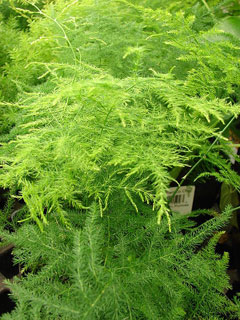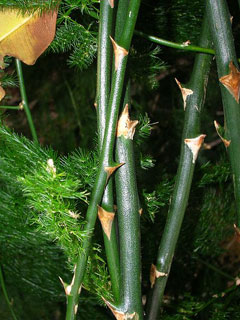 |
|
http://www.hear.org/starr/ |
 |
| http://www.hear.org/starr/ |
Translate this page:
Summary
Bloom Color: White.
Main Bloom Time: Early summer, Late summer, Mid summer. Form: Upright or erect.
Physical Characteristics

 Asparagus setaceus is an evergreen Climber growing to 3 m (9ft 10in) at a medium rate.
Asparagus setaceus is an evergreen Climber growing to 3 m (9ft 10in) at a medium rate.
See above for USDA hardiness. It is hardy to UK zone 9. It is in leaf all year. The species is dioecious (individual flowers are either male or female, but only one sex is to be found on any one plant so both male and female plants must be grown if seed is required). . The plant is not self-fertile.
Suitable for: light (sandy), medium (loamy) and heavy (clay) soils and prefers well-drained soil. Suitable pH: mildly acid, neutral and basic (mildly alkaline) soils. It cannot grow in the shade. It prefers moist soil.
UK Hardiness Map
US Hardiness Map
Synonyms
Protasparagus setaceus. (Kunth.)Oberm.
Plant Habitats
Cultivated Beds;
Edible Uses
Edible Parts: Shoots Stem
Edible Uses:
Young shoots[177]. No more details are given but it is likely that they are cooked and used like asparagus[K].
References More on Edible Uses
Medicinal Uses
Plants For A Future can not take any responsibility for any adverse effects from the use of plants. Always seek advice from a professional before using a plant medicinally.
None known
References More on Medicinal Uses
The Bookshop: Edible Plant Books
Our Latest books on Perennial Plants For Food Forests and Permaculture Gardens in paperback or digital formats.

Edible Tropical Plants
Food Forest Plants for Hotter Conditions: 250+ Plants For Tropical Food Forests & Permaculture Gardens.
More

Edible Temperate Plants
Plants for Your Food Forest: 500 Plants for Temperate Food Forests & Permaculture Gardens.
More

More Books
PFAF have eight books available in paperback and digital formats. Browse the shop for more information.
Shop Now
Other Uses
References More on Other Uses
Cultivation details
Landscape Uses:Container, Erosion control, Ground cover, Massing, Rock garden, Seashore. Easily grown in any good garden soil[200]. Prefers a rich sandy loam[1]. This species is not very cold-hardy in Britain, tolerating temperatures down to about -3°c[260]. It might succeed outdoors in the mildest areas of the country if given a warm sheltered position[200]. Dioecious. Male and female plants must be grown if seed is required. Special Features:
Attractive foliage, Not North American native, Naturalizing, Inconspicuous flowers or blooms.
References Carbon Farming Information and Carbon Sequestration Information
Temperature Converter
Type a value in the Celsius field to convert the value to Fahrenheit:
Fahrenheit:
The PFAF Bookshop
Plants For A Future have a number of books available in paperback and digital form. Book titles include Edible Plants, Edible Perennials, Edible Trees,Edible Shrubs, Woodland Gardening, and Temperate Food Forest Plants. Our new book is Food Forest Plants For Hotter Conditions (Tropical and Sub-Tropical).
Shop Now
Plant Propagation
Seed - pre-soak for 12 hours in warm water and then sow in spring or as soon as the seed is ripe in early autumn in a greenhouse. It usually germinates in 3 - 6 weeks at 25°c[134]. Prick out the seedlings into individual pots when they are large enough to handle and grow them on in a sunny position in the greenhouse for their first winter. Plant them out into their permanent positions in late spring or early summer[K]. Division in early spring as the plant comes into growth.
Other Names
If available other names are mentioned here
Native Range
AFRICA: Ethiopia, Kenya, Tanzania, Mozambique, Malawi, Zambia, Zimbabwe, Botswana, Lesotho, Eswatini, South Africa (KwaZulu-Natal, Free State, Eastern Cape, Northern Cape, Western Cape, Gauteng, Limpopo, Mpumalanga, North-West)
Weed Potential
Right plant wrong place. We are currently updating this section.
Please note that a plant may be invasive in one area but may not in your area so it's worth checking.
Conservation Status
IUCN Red List of Threatened Plants Status :

Growth: S = slow M = medium F = fast. Soil: L = light (sandy) M = medium H = heavy (clay). pH: A = acid N = neutral B = basic (alkaline). Shade: F = full shade S = semi-shade N = no shade. Moisture: D = dry M = Moist We = wet Wa = water.
Now available:
Food Forest Plants for Mediterranean Conditions
350+ Perennial Plants For Mediterranean and Drier Food Forests and Permaculture Gardens.
[Paperback and eBook]
This is the third in Plants For A Future's series of plant guides for food forests tailored to
specific climate zones. Following volumes on temperate and tropical ecosystems, this book focuses
on species suited to Mediterranean conditions—regions with hot, dry summers and cool, wet winters,
often facing the added challenge of climate change.
Read More
Expert comment
Author
(Kunth.)Jessop.
Botanical References
200
Links / References
For a list of references used on this page please go here
Readers comment
© 2010, Plants For A Future. Plants For A Future is a charitable company limited by guarantee, registered in England and Wales. Charity No. 1057719, Company No. 3204567.